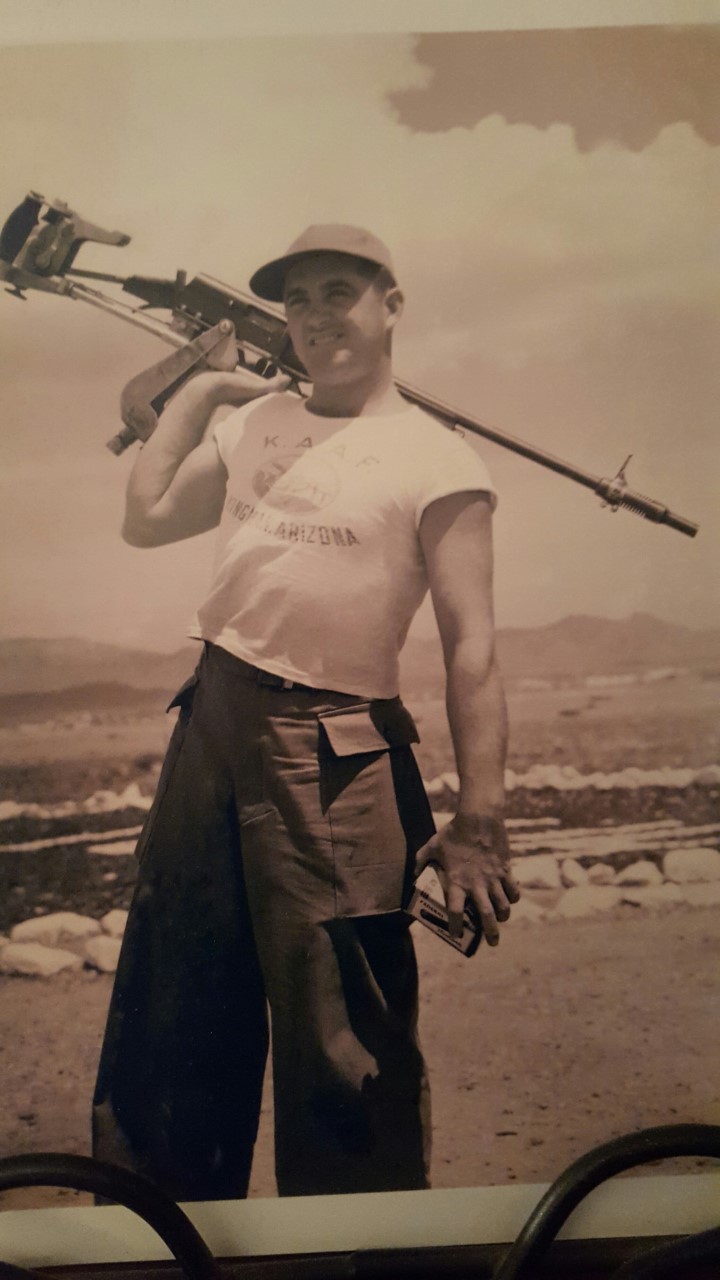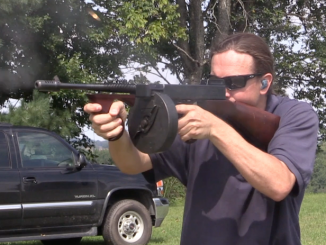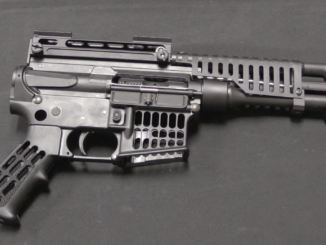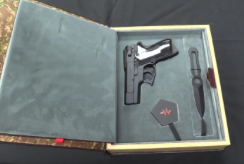
US gunner with a training weapon, a Browning Auto-5 or Remington Model 11 set up to emulate flexible-mount .50 caliber M2 Browning. The rear sight is not visible, but note the elevated front sight, the Cutts compensator, the M2 spade grips, and the pintle-monuted chassis that the gun is set into. Shotguns and thrown targets were used to train aerial gunners on things like leading that were not relevant to the infantry – and presumably to allow the use of training ranges where bullets are high angles would not be safe. Thanks to Jeff H. for the photo!




“to allow the use of training ranges where bullets are high angles would not be safe”
I am not expert in English language, but this seems to be broken.
Also notice ammunition box in left hand, I suspect that it is commercial one (has shot-shell picture and probably brand name, which I can’t read, maybe someone being expert of 1940s era US shot-shell boxes will recognize).
is: “(…) but this seems to be broken.(…)”
should be: “(…) but this sentence seems to be broken.(…)”
The word in the upper left-hand corner is “FEDERAL”, so I’m assuming it’s Federal-brand commercial ammunition.
Federal Cartridge Corporation, now Federal Premium Ammunition, was founded in 1916 and re-organized under new management in 1922. It was a major supplier of small-arms ammunition to the U.S. government during WW2, ranking 59th in cost of all U.S. government contractors;
https://en.wikipedia.org/wiki/Federal_Premium_Ammunition
cheers
eon
“to allow the use of training ranges where bullets _at_ high angles would not be safe”
^__^
If you elevate a .50 BMG so it’s shooting up into the sky you need about a 7000 meter splash zone of empty space down range. Otherwise you’re going to possibly kill people you aren’t intending to.
Probably the writer meant “(fired)at high angles…”
At least it’s more lethal than the BB guns used to train flak crews. Said BB guns had the sights removed so gunners would shoot targets instinctively rather than line up and waste precious time (as intended victims were also trying to kill gunners in the field)…
AAA shooting comes in three varieties;
1. High level- heavy guns, like the fabled German 8.8cm FlaK 36, the British 3.7in, or our 90mm, that fire with radar control and/or predictors;
2. Medium level- automatic guns ranging from 37mm on up to 50mm (experimental during the war) and 75mm or 76mm (postwar standard, mainly naval). They fire based on the same setup as the heavies, OR by local control visual aiming at the lower end of the scale (37mm and 40mm).
3. Low level- 20mm on down to rifle-caliber MGs. Pretty much all visually aimed by “the guy on the mount”, either hand-swinging a single gun or operating a powered turret with anything up to four. The latter is a lot like an aircraft turret setup, even if it’s in the back end of a halftrack. (U.S. M15 twin .50 or M16 quad .50, aka the “Meat Chopper” in Korea, where they were mainly used against Chinese “human wave” infantry attacks.)
Generally, firing “over open sights” was frowned upon for the heavies, and considered an improper use of the equipment for anything in the medium range much above the 37s and 40s. For the low level guns, it was pretty much the only way to go.
The ultimate non-naval expression of the medium-altitude, medium-sized gun going fully automated was probably the U.S. Army’s M51 Skysweeper 75mm of 1950;
https://en.wikipedia.org/wiki/M51_Skysweeper
Interestingly enough, it was designed to also be capable of being turned against ground targets, like tanks, if need be.
cheers
eon
“Interestingly enough, it was designed to also be capable of being turned against ground targets, like tanks, if need be.”
Were they provided with armor-piercing shells? If yes how thick armor it can pierce? I think that it would rather fail against most modern tanks, but anyway it could work against WW2-era surplus.
“M15 twin .50 or M16 quad .50″
There was also prototype of sextuple .50” mount on M24 Light Tank chassis – T77 Multiple Gun Motor Carriage:
http://www.ww2incolor.com/us-armor/usspg-M24-50cal.html
The most effective use of flak guns against tanks was to use air burst shells that would explode over the tank. This was not designed to pierce the tank’s armor, instead it killed all the personnel gathered around the tank using it for cover and would spray shrapnel down into any open top hatches. When the radio proximity fuse was used to get the timing just right, this became an extremely effective killing tool.
D,
A full auto 75mm gun equipped with a 20 round magazine firing a high velocity (even if only high explosive) would make a complete mess of even a modern MBT
Every single bit of vulnerable gear, from antennas, optics, tracks, bedrolls and even the paint would be flayed off. Whether the thank crew were to survive is another story but it’d be purely fatal to its infantry support.
The biggest danger to the gun crew would be emplacing and concealing something as tall and bulky as that.
But then during the war, the standard tactic of dealing with an enemy anti-tank gun was flanking it as their traverse was slow and limited. But holy crap, this one has a 360 degree high-speed traverse. Makes for pretty spry gunnery.
By the way, it also has two revolving magazines for a quick reload. You can be firing from one mag while reloading the other. Rated at up to 40 rounds a minute.
In case you’re wondering, I got to (sort of) play with one while stationed at Fort Sill at the artillery school. It was totally inert and being prepared for display and I can’t say I knew every thing there was to know about it…but there were people there that did know everything about it.
I’m not so sure a 1950’s vintage proximity shell would work the way you think, at least not on flat-trajectory direct-fire as you describe. Too much clutter on the way to the target. The mini radar set they had in those days was pretty rudimentary and they’d be just as likely to detonate while simply passing a building or a tree…or not at all. They were effective at detecting an airplane against a clear sky or coming down to earth from a steep angle. VERY effective, indeed. The Germans never did figure them out. They thought it had to do with the earths magnetic field. And the Japanese thought the US had equipped their ships with fully automatic 5″ guns. The proximity fuse was so secret they were not permitted to be fired over land until about the last year of the war, lest some enterprising German or Japanese reverse engineer a recovered dud.
Proximity shells capable of engaging ground targets with direct fire were not developed until the 1990s. Bofors 3P for the 40mm and 57mm automatic guns was one of the first. Oerlikon (now Rheinmetall) AHEAD for the 35mm guns provides a similar functionality, although with a programmable time fuze rather than proximity one.
US field artillery did use proximity (VT or Varable Time) fuzes already in WW2. They worked very well against soldiers in open trenches or foxholes, which is why post-WW2 entrenching manuals say that you should always have overhead cover if at all possible. The Soviets achieved proximity fuze tech through espionage. Julius Rosenberg was instrumental in providing the documentation to the Soviets; ironically, his role in atomic weapons espionage was minor.
Against armor , amount of shit thrown counts , I would guess those guns had a high rate of fire , treads , com gear , jamming turent ring or blinding them . Render a tank ineffective is almost as good as a kill ..
I got a tour of the USS Hornet (CV-8) from a guy who trained on her, and he showed us how to operate one of the 5-inch dual purpose guns (https://flic.kr/p/zTp8vu) which has two positions for layers: One tracks and controls only the up/down and the other only the left/right. When they both hold down their button the gun fires.
Whoops – CV-12 is the one I got tour of. CV-8 requires diving gear (it was sunk.)
The pretty much standard sights for land based 20mm AA guns in WW2 was a reflector sight, which is still the most sophisticated non-computing sight in existence. There were some exceptions like the Finnish twin barrel VKT 20mm AA gun, which had mechanical lead computing sight, but some people say that the German reflector sight was more practical for a 20mm gun. AA machine guns usually had simple ring sights, but the US M16 had a reflector sight as well. 37mm and 40mm guns usually had a mechanical or electro-mechanical lead computing sight.
Naval 20mm guns typically had simple ring sights, because reflector sights have optics which tend to fog up at sea. US and British multi-barrel 40mm and 2-pounder naval AA guns were radar controlled (RPC for Remote Power Control) at least from mid-war onwards. The British octuple Pom-poms had RPC from the beginning, if I remember correctly.
True about Julius and equally ironical as saying he was not the last to be killed by a proximity fuse. (Of course one could also say Ethel was done by a Remington typewriter.)
My (now late) Uncle Warren was on the front-line destroyer pickets intercepting the Kamikazi attacks off Okinawa, (until one landed on his turret, anyway.) He said the earliest and strangely most effective addition to at least the 20mm sighting was a simple polarizer lens to make the aircraft vusially stand out against the blue sky. Simple polarizing sunglasses worked well also and more than one submarine was sunk by merely cutting the glare from the water surface and seeing the target boat.
Truly oddly enough my mother, the Okinawa combat nurse, knew one of the Docs that supposedly could see slightly into the infra-red and was occasionally called on to identify possible camouflaged Japanese artillery positions. A handy talent for the all-day-every-day artillery duels.
I’m told really oddly enough is that my mother, uncle and even myself all lived on Okinawa at different and random times. My time was 20 some years later, but we were still picking up (live) land-mines and dud shells. Always made for interesting conversations at family gatherings.
They also used the quad .50 halftrack to guard large numbers of German prisoners late in the war since they knew nobody would try anything in the face of that mount.
Love the “Vintage Saturday’s” Ian! Also, I really like the new layout of the site. Keep up the great work! -Jacob S.
I have my father’s old Remington Model 31 pump action shotgun which he obtained from the Army Air Corps sometime in 1945. Dad was a brevet major, running a training base near Avon Park, Florida. The combat aircraft involved were the P-51 and the Martin B-26. He told me that most of the gunners on the Marauders had never fired a weapon of any kind before joining the Army. Civilian shotguns and clay pigeons were used as a cost effective means of teaching prospective gunners the art of leading the target before they moved on to more expensive and limited resources. Those that couldn’t learn were typically re-assigned to ground maintenance, losing flight pay as a result.
The Remington Model 31 was the last of their hand-fitted shotguns – after the war, it was simply too expensive to produce and was replaced in the market by the well known Model 870. I have used both, and much prefer the older 31 to any 870 I’ve used. At 80 years old, the gun is still smooth and reliable.
“I have used both, and much prefer the older 31 to any 870 I’ve used”
If you appreciate this weapon, you might be also interested in other slide-action weapons designed by John D. Pedersen, namely:
Remington Model 25 (.25-20 or .32-20 rifle)
Remington Model 141
Remington Model 121 (.22 rim-fire)
I have a copy of ‘Get That Fighter (restricted)’, provided to aerial gunners by the USAAF during the war.
Any chance of seeing a demo of this rig in modern times, or have all examples been scrapped?
A friend is a retired USAF AC130 gunner that does contracting for them now. They use WW2 40mm Bofors. He found some M42 Dusters on a target range and salvaged the guns, saving us a ton of tax dollars.
Observation. This A-5 is mounted in an E-11 or E-13 gun mount of the sort used in the flexible / waist gun positions of a B-17, 24 etcetera
Awesome pic! Perchance, Do you know if AAC also used side by side shotguns for aerial gunnery practice?
I once bought an Ithaca Lefever Nitro Special and when I took it down, there were flaming bomb, crossed-cannon and “P” stamps on the receiver and under the barrels. Any idea? -Peter
Mr. Becht is correct on the mount in the picture, a Bell design made by several different contractors. A K-13 compensating sight would mount on the platform above the grips, fed info by cable drive from the aircraft.